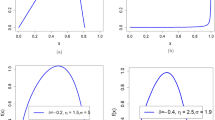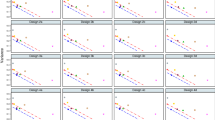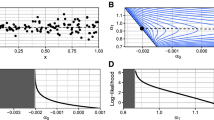Abstract
We define a new one-parameter model on the unit interval, called the unit-improved second-degree Lindley distribution, and obtain some of its structural properties. The methods of maximum likelihood, bias-corrected maximum likelihood, moments, least squares and weighted least squares are used to estimate the unknown parameter. The finite sample performance of these methods are investigated by means of Monte Carlo simulations. Moreover, we introduce a new regression model as an alternative to the beta, unit-Lindley and simplex regression models and present a residual analysis based on Pearson and Cox–Snell residuals. The new models are proved empirically to be competitive to the beta, Kumaraswamy, simplex, unit-Lindley, unit-Gamma and Topp–Leone models by means of two real data sets. Empirical findings indicate that the proposed models can provide better fits than other competitive models when the data are close to the boundaries of the unit interval.







Similar content being viewed by others
References
Aarset AS (1987) How to identify a bathtub hazard rate. IEEE Trans Reliab 36:106–108
Altun E, Hamedani GG (2018) The log-xgamma distribution with inference and application. Journal de la Société Française de Statistique 159:40–55
Altun E (2019) The log-weighted exponential regression model: alternative to the beta regression model. Commun Stat Theory Methods. Forthcoming
Cordeiro GM, de Castro M (2011) A new family of generalized distributions. J Stat Comput Simul 81:883–898
Cox DR, Snell EJ (1968) A general definition of residuals. J R Stat Soc Ser B (Methodol) 30:248–275
Dunn PK, Smyth GK (1996) Randomized quantile residuals. J Comput Graph Stat 5:236–244
Ferrari S, Cribari-Neto F (2004) Beta regression for modelling rates and proportions. J Appl Stat 31:799–815
Ghitany ME, Atieh B, Nadarajah S (2008) Lindley distribution and its application. Math Comput Simul 78:493–506
Grassia A (1977) On a family of distributions with argument between 0 and 1 obtained by transformation of the gamma and derived compound distributions. Aust J Stat 19:108–114
Gómez-Déniz E, Sordo MA, Calderín-Ojeda E (2014) The Log-Lindley distribution as an alternative to the beta regression model with applications in insurance. Insur Math Econ 54:49–57
Karuppusamy S, Balakrishnan V, Sadasivan K (2017) Improved second-degree Lindley distribution and its applications. IOSR J Math 13:1–10
Kieschnick R, McCullough BD (2003) Regression analysis of variates observed on (0,1): percentages, proportions and fractions. Stat Model 3:193–213
Kumaraswamy P (1980) A generalized probability density function for double-bounded random processes. J Hydrol 46:79–88
Mazucheli J, Menezes AFB, Dey S (2018a) Improved maximum-likelihood estimators for the parameters of the unit-gamma distribution. Commun Stat Theory Methods 47:3767–3778
Mazucheli J, Menezes AF, Dey S (2018b) The unit-Birnbaum-Saunders distribution with applications. Chil J Stat 9:47–57
Mazucheli J, Menezes AFB, Chakraborty S (2019) On the one parameter unit-Lindley distribution and its associated regression model for proportion data. J Appl Stat 46:700–714
Nadar M, Papadopoulos A, Kızılaslan F (2013) Statistical analysis for Kumaraswamy’s distribution based on record data. Stat Pap 54:355–369
Nadarajah S, Kotz S (2003) Moments of some J-shaped distributions. J Appl Stat 30:311–317
Topp CW, Leone FC (1955) A family of J-shaped frequency functions. J Am Stat Assoc 50:209–219
Author information
Authors and Affiliations
Corresponding author
Additional information
Publisher's Note
Springer Nature remains neutral with regard to jurisdictional claims in published maps and institutional affiliations.
Appendix
Appendix
The data for Sect. 6.2 are given below:
- 1.
Long term interest (LTI) rate (%): 2.640 0.596 0.680 2.190 4.560 2.140 0.410 0.530 0.750 0.280 4.390 3.390 5.190 0.800 2.160 2.640 0.060 2.549 0.930 0.310 0.540 7.750 0.470 2.810 1.760 3.170 1.760 1.010 0.990 1.318 0.550 0.040 1.374 2.890
- 2.
Foreign Direct Investment (FDI) stocks (Outward) (% GDP): 30.78 57.87 121.52 90.17 45.39 11.08 55.92 51.54 56.31 43.34 11.64 20.85 21.99 276.22 28.81 27.56 30.6 21.02 5.93 7.24 380.1 15.76 305.44 8.94 48.05 5.41 23.68 3.56 14.53 41.9 71.7 162.75 61.86 40.43
Rights and permissions
About this article
Cite this article
Altun, E., Cordeiro, G.M. The unit-improved second-degree Lindley distribution: inference and regression modeling. Comput Stat 35, 259–279 (2020). https://doi.org/10.1007/s00180-019-00921-y
Received:
Accepted:
Published:
Issue Date:
DOI: https://doi.org/10.1007/s00180-019-00921-y




